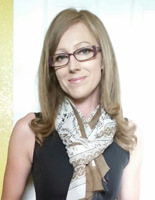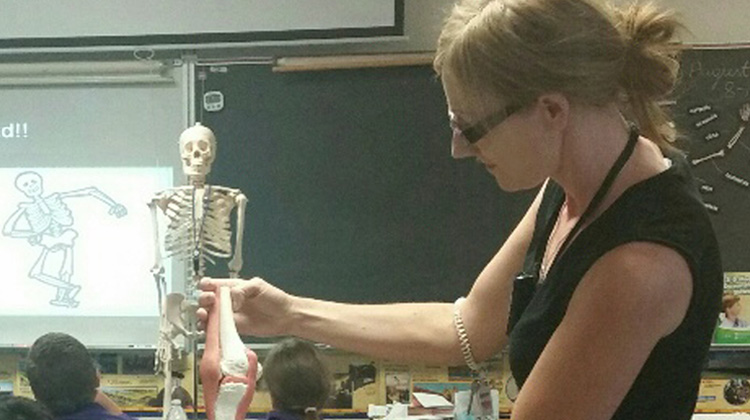This is the time of year when I begin poring through the hundreds of nominations that have come in for our annual LifeChanger of the Year awards.
As always, I’ve already come across examples of incredible dedication to bettering the lives of America’s children. We recognize 17 educators throughout the year with LifeChanger awards. But every one of them deserves recognition for the passion they bring to their work.
We thought it was worth shining a spotlight on some of that work by occasionally featuring their stories about how they work, often against great odds, to educate and inspire our next generation. Today, we want to share the lessons of Agnieszka (Aga) Cook, a fifth-grade teacher at Camp Mohave Elementary School in Fort Mohave, Ariz.
 By Aga Cook
By Aga Cook
Teaching is the mission of guiding each child throughout their journey of educational experience. Acknowledgment of uniqueness of each young adult in my class is the key to engaging them in meaningful learning. From day one in the classroom I understood it was necessary to be sensitive to their socio-economical situations, challenges and cultural diversity. As I think back to when I was my students’ age, I still remember the challenges my family and I experienced, growing up in communist Poland; a country that eventually evolved into a democratic system. As a teacher in a rural area I am aware that I have a responsibility to be effective at motivating my students to actively participate in their learning, encourage families in the involvement of their children’s education, as well as vigorously initiate and implement a variety of teaching resources in the classroom to enrich my students’ learning experience.
Through planning my instruction I know I have to be prepared to maximize every moment of the time I have with my students. To me, planning is considering how I can teach the content effectively, reach out to every child in my class, create lessons that are enjoyable and a rich learning experience for each of them, and assess with a variety of tools to reflect on my own teaching, including timely feedback and re-teaching as warranted. I continuously ask myself, “What can I do differently to enrich my students’ learning?”
In my class I have an open door policy to every parent willing to join the lesson as well as support through the learning process. I communicate with the parents via phone, daily homework e-mail, a weekly newsletter to keep them updated on the skills being introduced, and their child’s progress. I always share the positives that I witness when the students have their enjoyable learning moments. I want to continually build the level of trust by reaching out to the parents, getting to know them, gaining the knowledge of their child from their perspective, incorporate their suggestions and collaborate ideas regarding how we can team up to ensure my students have a successful year.
One of the most important teaching tools is technology. I take any opportunity to implement it across all the content areas in my curriculum. I create math word problems incorporating my students’ names to engage them in solving given tasks. I register my students in a variety of websites where they read fiction and nonfiction texts. As a teacher in a socio-economically disadvantaged area I have a responsibility to bring in all possible resources to create a rich learning environment. Thanks to DonorsChoose.org I received funding for eight classroom projects, such as an LCD projector, digital and paper subscription to Scholastic News, USA Studies Weekly and other nonfiction reading materials, limited in many households. I strongly believe that teaching through project based learning,while equipped with technology tools, allows my students to grow into independent thinkers and successful problem solvers.
My ultimate goal is to show my students how everything we learn relates to their life and the community in which they live. Recently, while teaching my students the skeletal system unit, I contacted a local hospital and invited their Director of Education to bring realia (the real world) to the class. How gratifying it was to see the amazed faces of children analyzing parts of the human skeleton, x-rays with various bone defects, or asking questions related to various careers in the medical field. One of my fifth grade projects is a Finance in the Classroom unit that concludes with a guest speaker’s visit from a local bank. My students learn about needs and wants, financial responsibility, filling out checks to pay for goods and services, as well as how to balance checkbooks. I want them to see the value of education in real life.
I describe myself as a team player who can work on a task independently as well as being able to take a directional role, recognizing input from others united for success on a complex task. I am aware that in the teaching profession I must initiate my own professional growth to improve my instruction and work with others towards our joint goal, educating every child to the best of our combined and individualized abilities.
I feel the two major rural educational issues are poverty and lack of resources. My responsibility as a teacher is to do everything I can to bring all available resources to my classes and to expose my students to what they cannot experience at home. I want them to discover how important education is and what great opportunities it brings to their future endeavors and life experiences. Their success is my goal.
TC99015(0118)1

